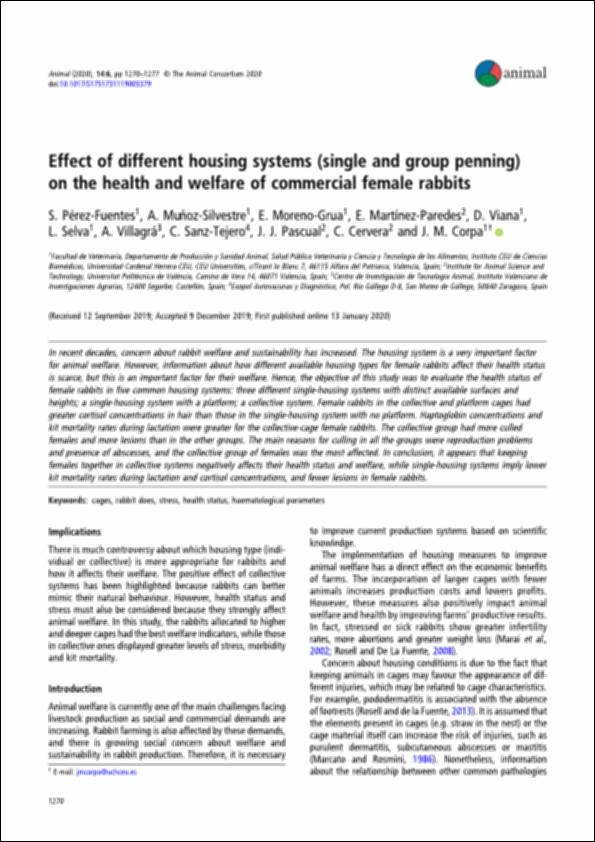Por favor, use este identificador para citar o enlazar este ítem:
http://hdl.handle.net/10637/12456Effect of different housing systems (single and group penning) on the health and welfare of commercial female rabbits
| Título : | Effect of different housing systems (single and group penning) on the health and welfare of commercial female rabbits |
| Autor : | Pérez Fuentes, Sara Muñoz Silvestre, Asunción Moreno Grúa, Elena Martínez Paredes, Eugenio Melchor Viana Martín, David Selva Martínez, Laura Corpa Arenas, Juan Manuel |
| Materias: | Conejos - Aspectos ambientales.; Rabbits - Environmental aspects.; Animal welfare.; Rabbits - Breeding.; Bienestar animal.; Cunicultura. |
| Editorial : | Elsevier. |
| Citación : | Pérez Fuentes, S., Muñoz Silvestre, A., Moreno Grua, E., Martínez Paredes, E., Viana, D., Selva, L., et al. (2020). Effect of different housing systems (single and group penning) on the health and welfare of commercial female rabbits. Animal, vol. 14, i. 6 (jun.), pp. 1270-1277. DOI: https://doi.org/10.1017/S1751731119003379. |
| Resumen : | In recent decades, concern about rabbit welfare and sustainability has increased. The housing system is a very important factor for animal welfare. However, information about how different available housing types for female rabbits affect their health status is scarce, but this is an important factor for their welfare. Hence, the objective of this study was to evaluate the health status of female rabbits in five common housing systems: three different single-housing systems with distinct available surfaces and heights; a single-housing system with a platform; a collective system. Female rabbits in the collective and platform cages had greater cortisol concentrations in hair than those in the single-housing system with no platform. Haptoglobin concentrations and kit mortality rates during lactation were greater for the collective-cage female rabbits. The collective group had more culled females and more lesions than in the other groups. The main reasons for culling in all the groups were reproduction problems and presence of abscesses, and the collective group of females was the most affected. In conclusion, it appears that keeping females together in collective systems negatively affects their health status and welfare, while single-housing systems imply lower kit mortality rates during lactation and cortisol concentrations, and fewer lesions in female rabbits. |
| Descripción : | Este artículo se encuentra disponible en la siguiente URL: https://www.sciencedirect.com/science/article/pii/S1751731119003379?via%3Dihub En esta investigación también participan: A. Muñoz-Silvestre, E. Moreno-Grua, E. Martínez-Paredes, D. Viana, L. Selva, A. Villagrá, C. Sanz-Tejero, J.J. Pascual, C. Cervera y J.M. Corpa. |
| URI : | http://hdl.handle.net/10637/12456 |
| Derechos: | http://creativecommons.org/licenses/by-nc-nd/4.0/deed.es |
| ISSN : | 1751-7311 1751-732X (Electrónico). |
| Fecha de publicación : | 1-jun-2020 |
| Centro : | Universidad Cardenal Herrera-CEU |
| Aparece en las colecciones: | Dpto. Producción y Sanidad Animal, Salud Pública Veterinaria y Ciencia y Tecnología de los Alimentos |
Los ítems de DSpace están protegidos por copyright, con todos los derechos reservados, a menos que se indique lo contrario.


